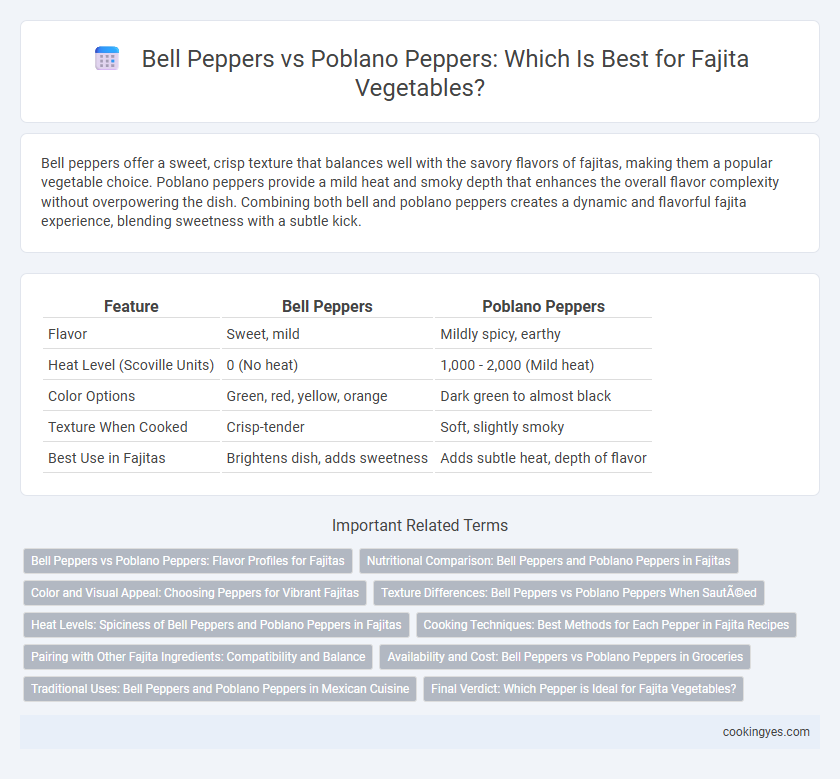Bell peppers offer a sweet, crisp texture that balances well with the savory flavors of fajitas, making them a popular vegetable choice. Poblano peppers provide a mild heat and smoky depth that enhances the overall flavor complexity without overpowering the dish. Combining both bell and poblano peppers creates a dynamic and flavorful fajita experience, blending sweetness with a subtle kick.
Table of Comparison
| Feature | Bell Peppers | Poblano Peppers |
|---|---|---|
| Flavor | Sweet, mild | Mildly spicy, earthy |
| Heat Level (Scoville Units) | 0 (No heat) | 1,000 - 2,000 (Mild heat) |
| Color Options | Green, red, yellow, orange | Dark green to almost black |
| Texture When Cooked | Crisp-tender | Soft, slightly smoky |
| Best Use in Fajitas | Brightens dish, adds sweetness | Adds subtle heat, depth of flavor |
Bell Peppers vs Poblano Peppers: Flavor Profiles for Fajitas
Bell peppers provide a sweet, crisp texture and vibrant color contrast essential for classic fajitas, enhancing the overall visual and taste appeal. Poblano peppers contribute a mild to medium heat with earthy, smoky undertones, adding depth and complexity to the fajita's flavor profile. Choosing between bell and poblano peppers influences the balance of sweetness versus spiciness, tailoring fajitas to preferences for milder or more robust, smoky vegetable layers.
Nutritional Comparison: Bell Peppers and Poblano Peppers in Fajitas
Bell peppers contain higher vitamin C levels, providing 80-150% of the daily value per serving, while poblano peppers offer a milder vitamin C content but contribute more dietary fiber. Poblano peppers have fewer calories and carbohydrates compared to bell peppers, making them a better choice for low-calorie fajita recipes. Both peppers add essential antioxidants and flavor, but bell peppers deliver a more vibrant nutrient boost in fajita vegetables.
Color and Visual Appeal: Choosing Peppers for Vibrant Fajitas
Bell peppers offer a bright and varied color palette, including red, yellow, and green, enhancing the visual appeal of fajitas with their vivid and eye-catching hues. Poblano peppers, with their deep green to dark brown shade, provide a more subdued but rich color contrast that complements the other ingredients without overpowering the dish. Selecting bell peppers emphasizes vibrant, multi-colored presentation, while poblanos contribute a rustic and earthy tone, making bell peppers ideal for those prioritizing bold, colorful fajitas.
Texture Differences: Bell Peppers vs Poblano Peppers When Sautéed
Bell peppers have a crisp texture that softens yet retains slight firmness when sauteed, providing a juicy bite in fajitas. Poblano peppers become more tender and slightly creamy upon cooking, offering a smoother mouthfeel that contrasts with the bell pepper's crunch. These texture differences make bell peppers ideal for added crunch, while poblanos enhance fajitas with a softer, richer vegetable component.
Heat Levels: Spiciness of Bell Peppers and Poblano Peppers in Fajitas
Bell peppers offer a mild, sweet flavor with virtually no heat, making them ideal for those who prefer a gentle, crunchy texture in fajitas. Poblano peppers provide a moderate heat level, typically ranging from 1,000 to 2,000 Scoville Heat Units (SHU), adding a smoky spiciness without overwhelming the dish. Choosing between these peppers depends on the desired heat intensity, with bell peppers suited for mild fajitas and poblanos enhancing the flavor with a subtle, spicy kick.
Cooking Techniques: Best Methods for Each Pepper in Fajita Recipes
Bell peppers, known for their sweet flavor and vibrant colors, benefit from high-heat sauteing or grilling to enhance their natural sweetness and maintain a crisp texture in fajitas. Poblano peppers, with a mild heat and earthy taste, respond well to roasting or charring, which brings out a smoky flavor that complements the savory elements of fajitas. Combining cooking techniques by sauteing bell peppers and roasting poblanos creates a balanced, flavorful vegetable mix ideal for fajita recipes.
Pairing with Other Fajita Ingredients: Compatibility and Balance
Bell peppers provide a sweet, crisp texture that complements the smoky, spiced flavor of grilled chicken or steak in fajitas, enhancing the overall balance with their vibrant color and mild sweetness. Poblano peppers offer a mild heat and earthy undertone that pairs well with rich, savory fillings like sauteed onions and seasoned beef, adding depth without overpowering other ingredients. Combining both peppers creates a harmonious flavor profile, balancing sweetness, heat, and texture to elevate the fajita experience.
Availability and Cost: Bell Peppers vs Poblano Peppers in Groceries
Bell peppers are widely available year-round in most grocery stores and typically cost less due to their high demand and mass production. Poblano peppers, while flavorful and slightly milder, tend to be less common in regular supermarkets and can be more expensive, especially outside of peak seasons. For fajita vegetables, bell peppers offer a cost-effective and easily accessible option, whereas poblanos provide a distinctive taste but may require specialty store visits and higher spending.
Traditional Uses: Bell Peppers and Poblano Peppers in Mexican Cuisine
Bell peppers are widely used in traditional fajitas for their sweet flavor and vibrant colors, adding a crunchy texture that balances the savory meat. Poblano peppers offer a milder heat and earthy taste, frequently roasted and peeled to enhance the smoky flavor in authentic Mexican fajita recipes. Both peppers contribute unique qualities, with bell peppers providing sweetness and poblano peppers delivering a subtle spiciness essential to regional fajita variations.
Final Verdict: Which Pepper is Ideal for Fajita Vegetables?
Bell peppers offer vibrant colors and a sweet, crunchy texture that complements fajitas with a mild flavor, making them a popular choice for a fresh and visually appealing dish. Poblano peppers provide a richer, slightly smoky taste with a mild to medium heat level, adding depth and a subtle spiciness ideal for those seeking a more robust flavor profile. The ideal pepper for fajita vegetables ultimately depends on preference: use bell peppers for classic, colorful fajitas or poblano peppers for a smoky, spiced variation.
Bell peppers vs Poblano peppers for fajita vegetables Infographic

 cookingyes.com
cookingyes.com